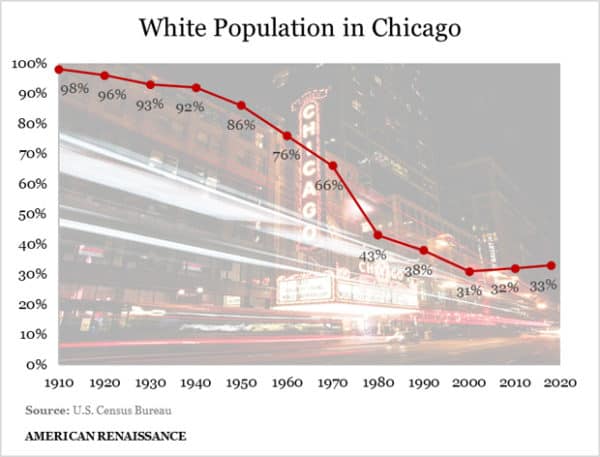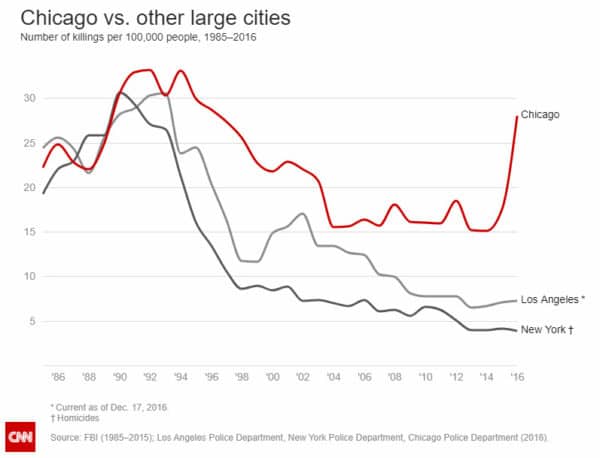The Great Replacement: Chicago
Gregory Hood, Paul Kersey, and Henry Wolff, American Renaissance, April 28, 2020
This is the fourth in a series about the continuing disappearance of whites from American cities (see our earlier entries for Birmingham, Washington, D.C., and New York City). Many people still pretend that The Great Replacement is a myth or a conspiracy theory, but the graphs that accompany each article in this series prove them wrong. Every city has a different story but all have seen a dramatic replacement of whites by minorities.
Chicago was once American socialism’s heartland. It was Saul Alinsky’s base. It hosted the International Socialist Review. Eugene Debs called it “the paragon city.” “CHICAGO WILL BE OURS!” screams the socialist organizer at the end of Upton Sinclair’s The Jungle.
It was also the place where the Old Left’s dreams collapsed in the face of racial reality. Martin Luther King Jr. famously suffered a crushing defeat when white workers and union members turned out to oppose his desegregation efforts. Chicago police, backed by Democrat mayor Richard Daley, brawled in the streets with New Left demonstrators at the 1968 Democratic National Convention. By the next year, the Black Panthers were promising to “kick [the] asses” of the mostly white Students for a Democratic Society (SDS) radicals and bring a new consciousness to the city and to America.
That kind of radical enthusiasm is dead. Today, Chicago, or “Chi-raq,” is a byword for black crime.
In 1910, Chicago was an almost entirely white city. In 1917, the Chicago Real Estate Board (CREB) said it would organize “owners societies in every white block for the purpose of mutual defense” to keep it that way. Blacks, it argued, would reduce property values. In 1926, the Supreme Court ruled in Corrigan v. Buckley that restrictive covenants to protect white neighborhoods were constitutional. In 1927, the CREB promoted a standard agreement throughout the city in white neighborhoods to stop blacks coming north during the Great Migration from buying property in white neighborhoods.
In 1948, the Supreme Court ruled against restrictive covenants in Shelley v. Kramer. Chicago’s white majority began to decline, from 92 percent in 1940 to just 76 percent by 1960. In 1966, Martin Luther King Jr.’s black demonstrators marched through white neighborhoods during the “Chicago Campaign.” Infuriated whites hurled insults and even rocks, one of which felled King. King said he had never “seen anything so hostile and so hateful as I’ve seen here today.” Then-mayor Daley promised vaguely to build more housing projects and create more integrated neighborhoods, but King later admitted he had been defeated and Daley was “a fox, too smart for us.”
Still, King ultimately got what he wanted. Chicago integrated and after that, it collapsed. By 1970, the white majority in Chicago was just 66 percent and it became minority-majority by 1980. In 1972, the Nation of Islam bought a former Greek Orthodox Church and turned it into its headquarters and central mosque. Homicides climbed during the 1960s and reached a record high of 716 in 1974. By 2017, the middle class, “once the backbone of the city” according to NPR, was “almost gone.”

In the early 1990s, crime declined nationwide for reasons that scholars still debate. Chicago also benefited. Still, residents and journalists called Chicago “Chiraq” because of its relatively high crime, even though homicides in 2010 were far below what they were in the early 1990s. In 2010, blacks and Hispanics accounted for 96 percent of murder and non-negligent manslaughter arrests and about the same percentage of weapons-violation arrests. Blacks were 24 times more likely than whites (p. 5) to be arrested for murder, and 27 times more likely to be arrested for robbery.
In 2016, homicides suddenly spiked.

What happened? In 2015, a white police officer shot a black teenager, and Barack Obama’s Justice Department conducted a high-profile “racism” investigation. Police blamed the subsequent increase in crime on cops’ fears of becoming the subject of the next “viral video” if they went after crime aggressively. Later, President Trump said he would “send in the Feds” if Chicago did not “fix” the “carnage” in the city.
In 2019, in a conversation about white flight, Michelle Obama said to whites, “Y’all were running from us, and you’re still running.” They had good reason to, but whites are now moving back into Chicago, partially because the Obama Presidential Center will be located in Jackson Park, part of a larger effort to make the south side fashionable again. These aren’t white workers like those in The Jungle, but gentrifying liberals. From 2017 to 2019, gun violence declined for three straight years, and this coincided with a slight increase in the white share of the population. Chicago is better off than it was just a few years ago. However, like New York City, it’s declining, and gentrification may have stopped.
Even when it was almost entirely white, Chicago was the city of corruption and Al Capone. Still, ten times as many people were shot in Chicago last July 4 weekend than during the “St. Valentine’s Day Massacre,” and 2019 was a relatively good year for the city. At the current rate, there will be more homicides and shootings in Chicago this year than last, even during what is supposed to be a coronavirus “lockdown.”
A century ago, many white socialists were race realists — like Jack London. No doubt they thought, like the Upton Sinclair character, that the city would be “OURS.” Now, a new form of socialism has come, along with gentrifying white liberals. Several “Democratic socialists” won power in recent local elections.
Unfortunately, Chicago is still “theirs.” It’s a white-minority city with the usual problems. Black progressive prosecutor Kim Foxx, who won election with help from George Soros, became a laughingstock after she dropped charges against Jussie Smollett for making up a hate crime. Mayor Lori Lightfoot, called a “historic” figure because she’s a black lesbian, also was the subject of mockery after she said she needed a lockdown-violating haircut during the virus outbreak because she was the “public face of the city.” The pandemic hasn’t stopped black gang violence. It hasn’t stopped blacks from hosting packed house parties. We should cite this video when people blame racism for the virus’s “disproportionate” impact on blacks. Here are celebrants crowding around a stripper at another “lockdown” house party.
Upton Sinclair’s plea for socialism in The Jungle inspired meat-packing regulation instead. Today, in black Chicago’s urban jungle, the worst pandemic in a century may be just an excuse to throw a party.















